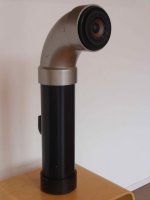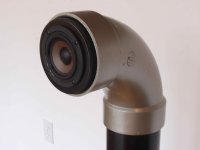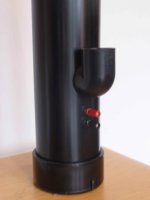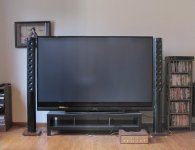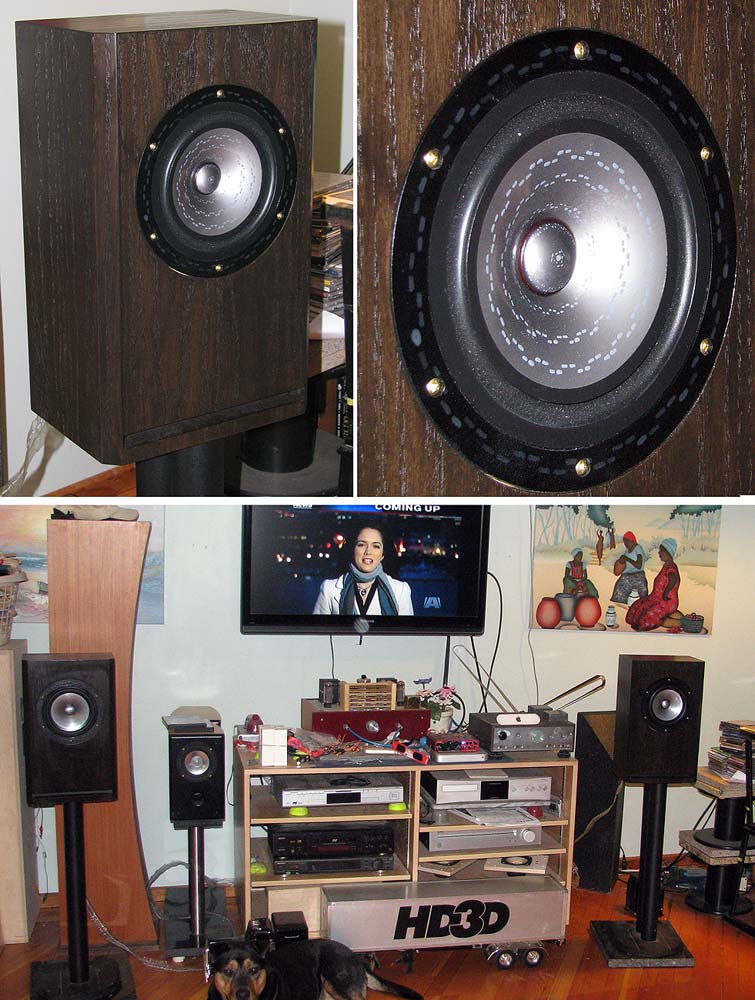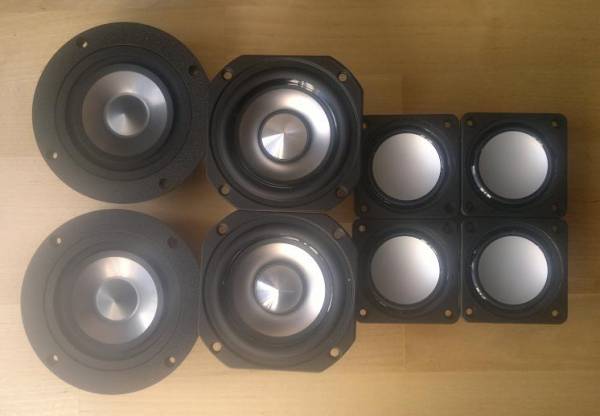RE: Seas Exotic F8 X1-08 (not a fighter plane).
Klang+Ton did a back loaded horn design with it [June 2010 issue of the Magazine - available via their site - in German] complete with plans and tests and an interesting front panel (?); Called "Unihorn". There is a 'kit' available (with or without the enclosure) via 'the Loudspeaker Shop' German web site - in English : Strassacker: Lautsprecher - Boxen - Selbstbau
Very interesting - if you have money to spare!
PVC Speakers
Threw these together over Christmas as a cheap pair of speakers for my son, although my wife has now claimed them. Drivers are TB W3-881S and the rest is heavy 4in PVC. It works out to be about a 4.5L enclosure with a 75 Hz port, although I think the actual port tuning is a bit lower. The PVC elbows were the most expensive part of the whole build. I wasn't expecting too much, but to my ears these sound surprisingly good.
Threw these together over Christmas as a cheap pair of speakers for my son, although my wife has now claimed them. Drivers are TB W3-881S and the rest is heavy 4in PVC. It works out to be about a 4.5L enclosure with a 75 Hz port, although I think the actual port tuning is a bit lower. The PVC elbows were the most expensive part of the whole build. I wasn't expecting too much, but to my ears these sound surprisingly good.
Attachments
It works out to be about a 4.5L enclosure with a 75 Hz port, although I think the actual port tuning is a bit lower.
As an ML-TL the port generated by a BR sim will be off.
dave
Abother Martello, with cocobolo front panels.
An externally hosted image should be here but it was not working when we last tested it.
An externally hosted image should be here but it was not working when we last tested it.
Finally! Putting my HT speakers into service
A couple months ago I posted about some HT speakers I was working on and posted a photo of some prototypes. Well, I've finally completed a couple (I am building 8). I must say, doing 8 of a speaker is definitely a task of a different order of magnitude than doing one or two. However, within a week a two I think I should have them all finished, and then I will have to provide the multi channel amplification, etc. to utilize their potential. Time permitting, I will add perforated metal grilles that will follow the enclosure's cylindrical profile.
I went to significant trouble to get the best possible bass extension from these speakers, and listening to the results so far, I am actually giving some consideration to not using subwoofers. These are sealed enclosures, but to help the bass out, as I mentioned earlier, I am softening the spiders on the 3 1/2" drivers to get the free air resonance below 62 hz (one driver in this pair came out at 46hz - imagine that from a 3 1/2" driver. Freaky!) Then I am using a 600uF ASC GLY-513 polypropylene capacitor in the xover to reduce the effective Vas of the drivers (the entire xover including this large cap is enclosed within the speaker). Finally, I am adding a considerable amount of activated charcoal and a 'molecular sieve' desiccant to the enclosure that increases the enclosure air compliance by up to 2x overall. The rest of the enclosure volume is moderately filled with long fiber wool. The result is usable bass down to below 40 hz, although it is definitely rolling off below 50 - 60 hz. All that charcoal in the enclosure (below the drivers) adds significant mass and stability, and I have also added 1.5 lb lead weights at the top to minimize enclosure rocking for more a more stable image.
With 9 3-1/2" aluminum cone drivers each capable of 4mm peak linear excursion, the total air moved is comparable to a 10" driver. I have xovered it so that the center driver has a response peaked up to 10db at 20khz so that the system response is reasonably flat up to at least 15 khz or so without a dedicated tweeter. The effect is basically a vertically elongated point source. The basic enclosures are 5" diameter schedule 40 CPVC pipe which gives excellent horizontal dispersion (with baffle step being above 1khz) and the bases are solid walnut.
Still tweaking the xover a bit, but I am pretty satisfied with the overall results.
A couple months ago I posted about some HT speakers I was working on and posted a photo of some prototypes. Well, I've finally completed a couple (I am building 8). I must say, doing 8 of a speaker is definitely a task of a different order of magnitude than doing one or two. However, within a week a two I think I should have them all finished, and then I will have to provide the multi channel amplification, etc. to utilize their potential. Time permitting, I will add perforated metal grilles that will follow the enclosure's cylindrical profile.
I went to significant trouble to get the best possible bass extension from these speakers, and listening to the results so far, I am actually giving some consideration to not using subwoofers. These are sealed enclosures, but to help the bass out, as I mentioned earlier, I am softening the spiders on the 3 1/2" drivers to get the free air resonance below 62 hz (one driver in this pair came out at 46hz - imagine that from a 3 1/2" driver. Freaky!) Then I am using a 600uF ASC GLY-513 polypropylene capacitor in the xover to reduce the effective Vas of the drivers (the entire xover including this large cap is enclosed within the speaker). Finally, I am adding a considerable amount of activated charcoal and a 'molecular sieve' desiccant to the enclosure that increases the enclosure air compliance by up to 2x overall. The rest of the enclosure volume is moderately filled with long fiber wool. The result is usable bass down to below 40 hz, although it is definitely rolling off below 50 - 60 hz. All that charcoal in the enclosure (below the drivers) adds significant mass and stability, and I have also added 1.5 lb lead weights at the top to minimize enclosure rocking for more a more stable image.
With 9 3-1/2" aluminum cone drivers each capable of 4mm peak linear excursion, the total air moved is comparable to a 10" driver. I have xovered it so that the center driver has a response peaked up to 10db at 20khz so that the system response is reasonably flat up to at least 15 khz or so without a dedicated tweeter. The effect is basically a vertically elongated point source. The basic enclosures are 5" diameter schedule 40 CPVC pipe which gives excellent horizontal dispersion (with baffle step being above 1khz) and the bases are solid walnut.
Still tweaking the xover a bit, but I am pretty satisfied with the overall results.
Attachments
Last edited:
Btw, I should mention that baffle step correction is achieved by rolling off the outer six drivers at 1khz (give or take) with a first order slope, and the two speakers surrounding the center driver mentioned above are rolled off at about 4khz, again first order. This eliminates most, if not all potential phasiness due to the vertical array arrangement.
One thing that took a little thought was how to mount the asc gly-513 caps inside the 5" cpvc pipe. When I realized that the diameter of these caps was just about a sixteenth of an inch less than the inner diameter of a 3" schedule 40 PVC pipe, I was set. I cut and glued up a ~6" section of the pipe with a pvc end cap cover and internal pvc plate tapped to accept the threaded stud on the asc capacitor, and attached a pvc toilet floor flange trimmed to the id of the 5" cpvc pipe to the other end of the 3" pcv pipe section. This provided both a mounting for the large asc cap and the bottom seal for the enclosure. Below this is the rest of the xover network which mounts on a removable disc at the bottom of the walnut base.
The charcoal and molecular sieve (this is stuff that is put between panes in sealed window units to prevent internal condensation, and, until saturated, will keep the RH below about 10%, allowing the charcoal to be maximally effective as a compliance enhancer) are each in its own internal compartment and are kept by nylon screening from moving elsewhere in the enclosure. The activated charcoal is (as previously mentioned) in the base and the molecular sieve is right at the top, above the drivers. A removable PVC plug for each allows access and replacement if necessary for both if it should ever be needed.
One thing that took a little thought was how to mount the asc gly-513 caps inside the 5" cpvc pipe. When I realized that the diameter of these caps was just about a sixteenth of an inch less than the inner diameter of a 3" schedule 40 PVC pipe, I was set. I cut and glued up a ~6" section of the pipe with a pvc end cap cover and internal pvc plate tapped to accept the threaded stud on the asc capacitor, and attached a pvc toilet floor flange trimmed to the id of the 5" cpvc pipe to the other end of the 3" pcv pipe section. This provided both a mounting for the large asc cap and the bottom seal for the enclosure. Below this is the rest of the xover network which mounts on a removable disc at the bottom of the walnut base.
The charcoal and molecular sieve (this is stuff that is put between panes in sealed window units to prevent internal condensation, and, until saturated, will keep the RH below about 10%, allowing the charcoal to be maximally effective as a compliance enhancer) are each in its own internal compartment and are kept by nylon screening from moving elsewhere in the enclosure. The activated charcoal is (as previously mentioned) in the base and the molecular sieve is right at the top, above the drivers. A removable PVC plug for each allows access and replacement if necessary for both if it should ever be needed.
Last edited:
Then I am using a 600uF ASC GLY-513 polypropylene capacitor in the xover to reduce the effective Vas of the drivers....
Still tweaking the xover a bit, but I am pretty satisfied with the overall results.
What is the amplifier on the floor in front of the right speaker? It looks alarmingly like an old Fisher (Avery Fisher).
MPM -
Glad you like them! I was afraid they would turn out to be uglier/more obtrusive looking, but they seemed to come out ok visually. I checked out the IDS 25 web page. A really impressive speaker. (And price! I'm building eight of mine for about $1K give or take all told, of course with a fair amount of sweat equity added.) I kind of grouped the drivers away from the floor in my design. One reason for that is that I wanted all (or most) of them to be able to fire over a typical end table so I could tuck the side channels in more out of the way places without affecting their sound too much.
The IDS25 certainly approaches a true line source much more closely than the ones I built. It is designed to a somewhat different philosophy, of course. I could have made the speakers much deeper like the IDS 25 except the whole project would have cost a few hundred dollars more for the extra sheet PVC, or I could've done the back portions in baltic birch since the PVC in the thickness I used (generally 1/4" to 3/8") would be far less rigid in a flat panel than the plywood. As a cylinder with a small flat for speaker mounting this more or less is not an issue.
Of course, I took extra measures (as I mentioned in previous posts) to increase the compliance of the internal air volume with the restricted internal volume I had, but much the same result could have been obtained by using, say, a 7" diameter tube without the charcoal and molecular sieve, or making the cabinet deep like the IDS 25.
I decided to use a passive rather than active xover, partly for frequency shaping of the drivers in groups and partly to minimize any potential 'phasiness', although I'm not saying that I would have noticed a problem with it with this design if I hadn't. I decided I didn't want to add any external 'eq', and of course my speakers are falling off below 50hz, but to tell the truth, with only 9 drivers, I think they would have been working harder than I would have preferred if run down flat to 20 hz IAC (as far as generating doppler/IM products), but either approach is certainly feasible. I haven't verified this yet, but they shouldn't have any large dips below 8 ohms at any frequency.
As far as doing a 'how-to' page, I can take some photos and describe what I did. (2 are complete and the other 6 enclosures are complete waiting for the drivers and xovers to be installed.)
With the long fiber wool & charcoal in the enclosure, I can say that there is little to no evidence of a pipe resonant mode or internal reflections in general when playing music or tapping a driver cone.
Navin -
The amp in the foreground is a trusty old Scott integrated. Eventually, I will put in a real HT 7.1 receiver/amp combination.
Glad you like them! I was afraid they would turn out to be uglier/more obtrusive looking, but they seemed to come out ok visually. I checked out the IDS 25 web page. A really impressive speaker. (And price! I'm building eight of mine for about $1K give or take all told, of course with a fair amount of sweat equity added.) I kind of grouped the drivers away from the floor in my design. One reason for that is that I wanted all (or most) of them to be able to fire over a typical end table so I could tuck the side channels in more out of the way places without affecting their sound too much.
The IDS25 certainly approaches a true line source much more closely than the ones I built. It is designed to a somewhat different philosophy, of course. I could have made the speakers much deeper like the IDS 25 except the whole project would have cost a few hundred dollars more for the extra sheet PVC, or I could've done the back portions in baltic birch since the PVC in the thickness I used (generally 1/4" to 3/8") would be far less rigid in a flat panel than the plywood. As a cylinder with a small flat for speaker mounting this more or less is not an issue.
Of course, I took extra measures (as I mentioned in previous posts) to increase the compliance of the internal air volume with the restricted internal volume I had, but much the same result could have been obtained by using, say, a 7" diameter tube without the charcoal and molecular sieve, or making the cabinet deep like the IDS 25.
I decided to use a passive rather than active xover, partly for frequency shaping of the drivers in groups and partly to minimize any potential 'phasiness', although I'm not saying that I would have noticed a problem with it with this design if I hadn't. I decided I didn't want to add any external 'eq', and of course my speakers are falling off below 50hz, but to tell the truth, with only 9 drivers, I think they would have been working harder than I would have preferred if run down flat to 20 hz IAC (as far as generating doppler/IM products), but either approach is certainly feasible. I haven't verified this yet, but they shouldn't have any large dips below 8 ohms at any frequency.
As far as doing a 'how-to' page, I can take some photos and describe what I did. (2 are complete and the other 6 enclosures are complete waiting for the drivers and xovers to be installed.)
With the long fiber wool & charcoal in the enclosure, I can say that there is little to no evidence of a pipe resonant mode or internal reflections in general when playing music or tapping a driver cone.
Navin -
The amp in the foreground is a trusty old Scott integrated. Eventually, I will put in a real HT 7.1 receiver/amp combination.
Last edited:
Very nice. The only place they fall down vrs the smaller Alpairs is that they don't image as well (a symptom of less downwad dynamic range?). Big, dynamic, excellent tone.
dave
woofer optional

Love the woofer at the bottom of the pic.
ZaBu, short for Zaboomafoo, named after the TV show by our (then almost 4 yo) godson. A designer dog (Miniature Pincher, Belgian Terveran, Chinese Sharpea, Boston Terrior (i can't guarantee the spelling on all of those
I am so curious how all of the speakers in the pic compare to one another... among some others that might be just in the other room.
Only a set of mFonken "off screen", most are downstairs. Buried in the back are the FF85/EL166 (Mark Audio #6 woofer) MTM sound really good still detailing the XO. Frugel-Horn with Alpair7eN are ahead of the oack, but i strongly suspect will fall behind Maeshowe with the same drivers once i bring the air cavity from experimental to spec (and add a bit of damping maybe), The JX92 in the Jim Griffin BR come in last (they don't have the advantage of being EnABLed)
dave
I don't normally care for the look of enabling
I see a driver without it looks unfinished, naked.
dave
- Home
- Loudspeakers
- Full Range
- Full Range Speaker Photo Gallery

